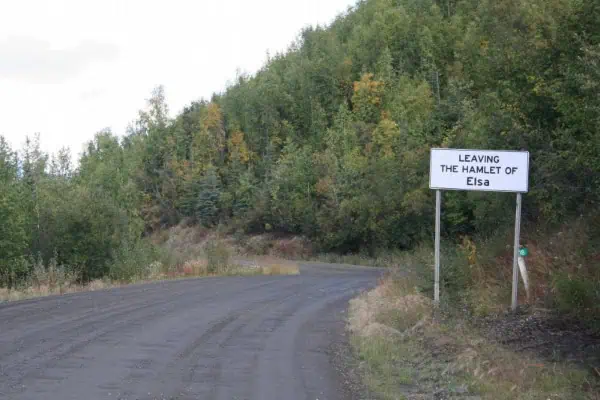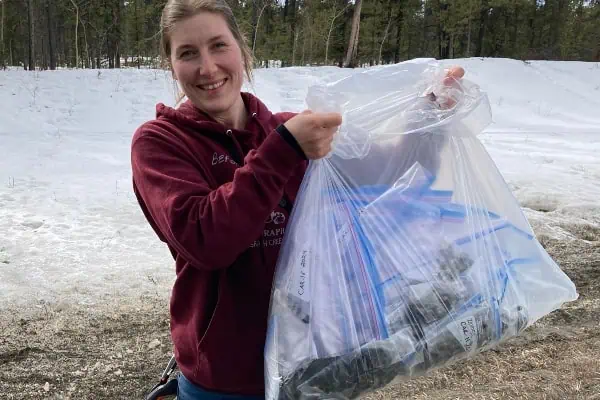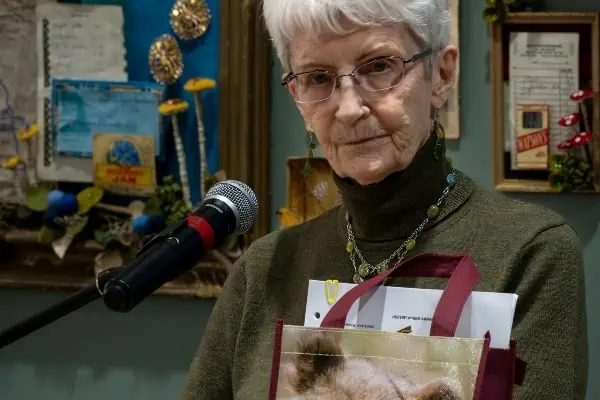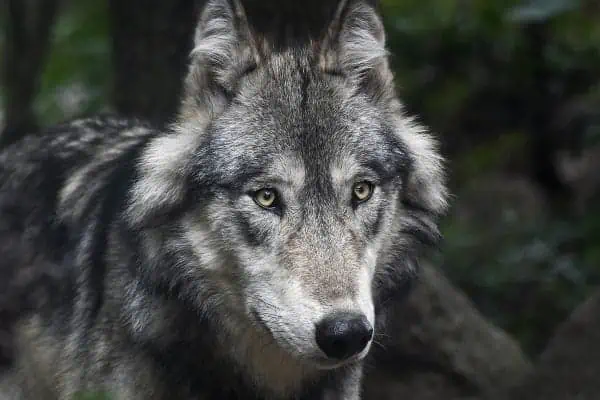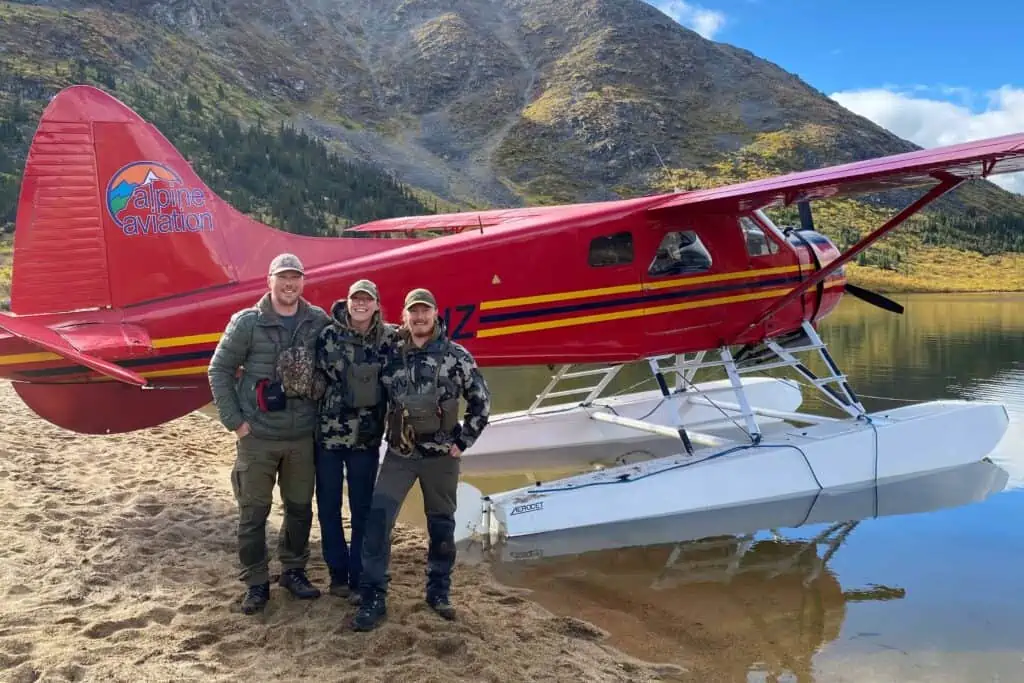
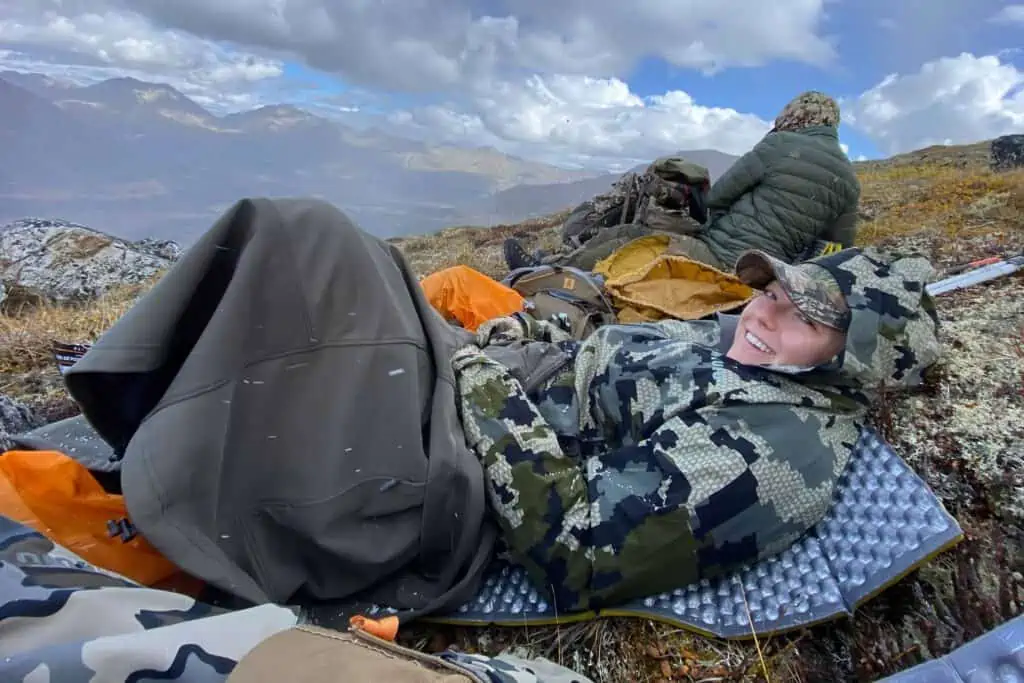
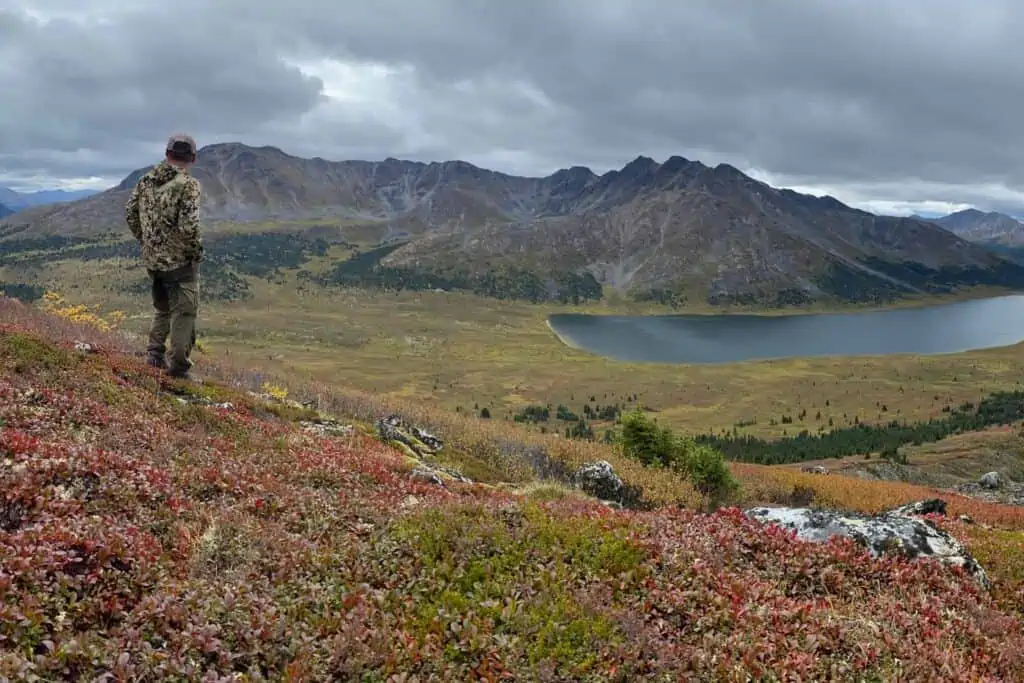
An hour before dawn, my alarm goes off like a foghorn behind my head. I frantically reach behind me to shut it off. There’s no need to rouse anyone else this early. I rub my swollen, tired eyes and slowly exhale, bracing myself for what promised to be an exciting but exhausting day in the alpine. I pause for a second and hear my partner Lisa’s soft, unlaboured breathing. My older brother Mike is lying motionless on the other side of the tent … his breathing a bit heavier than hers, but the pair lie undisturbed like a pair of modern-day mummies. I’ll let them sleep a little while longer, I think. If it’s anything like our other trips, we’ll need all the energy we can muster over the next week.
I quickly pull on some down layers and quietly slip outside the comfortable glow of our warm wall tent, and my face is instantly greeted by the cool tingle of morning mountain air. It’s autumn in the Yukon, and the willows adorn the brilliant seasonal regalia of red, yellow and orange. A thick fog is hanging eerily over the lake and, every few seconds, clears just enough to glimpse the mountaintops, which are now dusted in a fresh coat of the white stuff. Together, the colours create a magical scene, one I deliberately pause to take in as I wait on the water to boil for the first round of coffee.
The spectacle before me is short-lived in the North. While fall may be a season of proportional length in other parts of the country, up here the mystique and vibrant characteristic of the autumnal equinox can be missed in the blink of an eye. I sit silently, with my back propped up against a knobby chunk of driftwood, trying to soak up what I understand to be a fleeting moment of tranquility. It doesn’t matter how many mountains or valleys I explore; I’m always mesmerized by the unique character and boundless majesty of each new one. “Wow,” I found myself quietly muttering to no one, for what surely wouldn’t be the last time.
These small moments in nature are so important to me. It breathes life back into my fatigued and frantic city-worn mind. I pause to reflect, for a minute, on all the little experiences that have led us on this grand, remote adventure. And I wonder if this journey will have a different outcome than all the ones that came before it. This uncertainty is the enigma inherent in the pursuit of wild things. I close my eyes as I listen to the wind moving through the mountains.
It’s now sunrise on the first morning of a ten-day caribou hunt that the three of us have been scheming for the better half of a year. A lot is riding on the line.
This year, Lisa drew a coveted Special Guide License (SGL) allowing Mike, an Ontario resident, to lawfully harvest either a caribou or a moose under her tutelage. These SGLs are drawn by way of a weighted lottery system, and after hosting my dad, last year, it’ll be several years before I draw the permit again. Fortunately for us, “Lucky Lisa” had been accumulating some weighting (a process called a “weighted lottery” with accumulated points to draw the special guide license) and was keen to have Mike join our annual caribou hunt.
The way we found out about the draw results was hilarious. I was sitting at work on a warm day, earlier this spring, when my phone vibrated. It was a message from Lisa in a new group chat with Mike. That’s odd, I thought. The message simply read, “GUYS!!!” I knew right away what had happened. We were getting another kick at the can. And just like that, we had a great little family team, with a singular focus—to get Mike on his first big-game animal in the Yukon.
On multiple occasions, over the years, Mike used his precious vacation time to fly across the country, just to join me on a hunt as an observer and pack mule. He may not be a Yukoner on paper, but that hasn’t prevented him from ingraining its values and culture into his very DNA. To date, we’ve been on six big-game hunts in the Yukon, and in that time we’ve never harvested an animal together. We’ve had some memorable wildlife encounters, but the stars haven’t aligned for us.
On the other hand, Lisa and I have had our fair share of luck together, over the last few years, both good and bad. And we’ve learned a lot about what to anticipate on a caribou hunt. Always expect the unexpected. Someone once described a caribou encounter to me as a lightning strike. It’s an analogy I often recycle, now, mainly when people express interest in learning how to hunt them. There’s a lot you can try to plan and account for before you walk out your front door, but, in the end, the situation you’ll find yourself in will likely be entirely unplanned. So when Mike said he wanted to bring his bow and rifle and do whatever was necessary to find and harvest a mature bull caribou, well, I knew we were in for a hell of an adventure. Mike is no stranger to the glory and the perils of spending extended periods in the mountains of the Yukon. In fact, for a non-resident, he’s already seen his fair share of backcountry adventures gone awry.
The last time I drew the SGL tag for him was in 2018. I dragged him on a week-long goose chase through the mountains, to harvest a caribou on that hunt. After days of wandering, we did eventually find our quarry. But we were ultimately stymied by a long-distance pack out, an equally interested grizzly bear and a fast-approaching snowstorm. We had already endured days of unrelenting rain and extremely high winds (leading to catastrophic gear failures). Followed by unseasonably cold overnight temperatures, frozen boots and over eight inches of thick wet snow. After hundreds of kilometres on foot and so many hardships, missing our only opportunity at a caribou was a tough pill to swallow.
Everyone who spends time in the bush in the Yukon experiences this at some point. It was Mike’s baptism by fire. But this hunting story begins almost a decade ago, on the edge of a windy lake in late September. I’d been living here for just over a year and was finally eligible to purchase a Yukon big-game hunting license. Naturally, as two naive young brothers will, we decided to swing for the fence and tackle an unsupported 10-day river moose hunt. That journey had us paddling a loaded freighter canoe, over 400 kilometres, after an engine failure on the first day. Then, after a crash landing later that night, we accidentally burned a hole in our tent’s floor while lighting an emergency fire, and before long we were removing over 40 quills from my dog’s face, saving the dog from nearly drowning in a logjam and then waking up to the sound of him biting through a can of bear spray, just a few hours later. We also lost a life jacket and a paddle halfway down the river, where we endured countless close calls with sweepers and snags.
At one point on that river trip we were hung up on a rock in the middle of a set of rapids, and I remember looking back at Mike in the stern. He was almost beneath me. We then spun one hundred and eighty degrees, slipped backwards into the water and went straight into a logjam. The dog, who was only about a year old, then, was not very impressed by the ordeal and, not surprisingly, still detests freighter canoes to this day.
At this point, I should mention that Mike and I grew up in an active outdoor family in southern Ontario. We spent our childhood adventuring through the bush and on the water near our family property. As kids, our parents intentionally exposed us to challenges that they hoped would teach us the importance of being motivated, self-sufficient and persistent problem solvers.
And so, here we are today, deep in the Pelly Mountains, looking to finally solve our great enigma, once and for all. As the sun pokes above the ridgeline, I decide it’s time that these two begin to show some signs of life. So, I slowly walk behind the tent and make a long, drawn-out cow moose call. They both emerge from the tent, within a few minutes, ready to go. As we make our way down the shore, a few hundred yards toward our food cache, I see a large brown body standing in the willows near the treeline. I stop walking, falling behind the others, and raise my binoculars. “A bull moose is standing right there,” I whispered. “Ahead.” They both stop in their tracks.
“Where?!” Mike asked, with a hint of disbelief in his voice.
“Right up there, by the tree line, standing near the lone spruce tree,” I replied while pointing.
Mike raises his binoculars and swallows hard. “Shit,” he muttered. I know he’s only upset because we specifically set out to harvest a bull caribou. And while he can legally harvest this moose, instead, it would mean deviating from “the plan”—in a big way.
“He’s a nice bull,” I reassured him. “But we’re going to be here for over a week if he hasn’t already paired up with a cow and hears us calling. I doubt he’ll be going anywhere. Let’s leave him for a few days. If the area doesn’t look promising for caribou, then we can change gears.”
The logic sticks because now Mike is walking back to camp. “I’m all-in for caribou,” he said, then walks away.
The next few hours are spent dragging Mike through six-foot-high willows, up and down ridges and glassing from the peaks and benches of the surrounding mountain range. Just as the afternoon draws to a close, I spot the bull moose, from earlier this morning, and we watch him for another hour or so. He’s moved about 200 yards, over the course of the day, and appears to be more concerned with raking his remaining velvet off than with the impending rain clouds.
We called it a day, deciding to head back to camp, get an early rest and scout the range to the south of the lake in the morning.
As we begin to descend a steep scree slope, my brain does its usual spin-out. And suddenly I realize there’s a whole bunch of terrain that I haven’t glassed yet. Probably because I’ve been too busy watching our moose friend most of the afternoon. So I spend the next few minutes scouring any alpine bench that looks like it will support caribou. (You don’t always find animals in the open where you might expect to see them.)
But sometimes, as a Hail Mary, quickly checking those obvious habitats can effectively cover large areas. My eye keeps returning to a sizable horse-shaped rock on the horizon, deep on the other side of the valley. I can barely discern the shape with my binoculars. I tell Mike and Lisa about it, almost as if to dissuade myself from investigating it further.
Mike bites … “Oh yeah, well, it’s probably worth looking. We still have some daylight.”
I immediately spot a beautiful, wide-framed bull caribou, about five kilometres away, set regally against the skyline, its antlers towering to the sky like a dead poplar tree that sailed into the alpine and managed to take root. “Guys, I’m looking at a really nice bull caribou, right now,” is all I could think of to say.
Mike hurries toward my spotting scope, as if to say “Let me have a look.” He stares through it, for a minute, without talking, and then removes his eye from it, biting his lip.
Lisa also leans over for a look. “Oh, wow,” she said calmly. (Her cool demeanour makes her one of the best hunting partners I’ve ever had.)
“Okay, let’s talk this one out,” I suggested.
Lisa looks over at me. “It’s too late in the day, Steve. We’d never make it there before dark.”
I knew she was right, but one of the lessons I’ve learned the hard way, over the years, is that when you’re presented with an opportunity, you need to be ready and willing to take it. Sometimes that means taking the hard road.
“Okay, but if we left now and got there before dark and it was still there, we could harvest it. We’d be packing it out at night, but we all have good headlamps,” I countered.
“No,” Mike immediately chimed in. “It’s not worth the risk involved with packing it out in the dark. Let’s hike back up tomorrow and see if we can spot him again.”
Deep down I knew it was the right decision, so I reluctantly began to pack up and we continued down the mountain.
It’s the morning of our second day and, before my alarm goes off, I slide out of my sleeping bag and stoke the fire for the two sleeping mummies. Then I begin my usual routine of morning chores and moose calling. It’s already shaping up to be a bluebird day and, as you might expect, it’s much colder. A heavy sheet of frost envelops the valley in little diamonds of condensation, and the small ponds adjacent to the lake are frozen. I drown out the quiet roar of the boiling water, with another long cow moose call, and think, The colours must be peaking today. Vivid reflections of colourful willows rippled across the glassy lake, disturbed only by a school of grayling quietly sipping at the surface.
Not having a rod in hand would typically be a major letdown. But in that moment, my mind was still playing back scenes of the caribou from yesterday. I drifted off into a daze, daydreaming about seeing the animal again.
A few minutes pass before Mike emerges from the tent and we make a few more cow calls. We cheerfully sip coffee and recount stories from the day before as we watch the (now) local bull moose. He’s only moved a short distance down the valley from where we first spotted him. I pull my spotting scope out and start filming him reacting to our cow calls. Suddenly, we hear a low grunt and he’s trotting through the willows at an astounding rate. He’s coming right at us. Without blinking, Mike grabs his bow from a nearby branch and takes off up the hill. He’s clearly keen to close the gap on this moose from a higher vantage. “What? … Mike! … What the hell are you doing? Where are you going? Mike!” was all I had time to whisper as I collapsed the tripod. I take off after him. It’s become readily apparent that Mike thinks if this moose is willing to give him a bow shot, he’s willing to take it.
See the conclusion of Steve’s story next week on www.whatsupyukon.com

